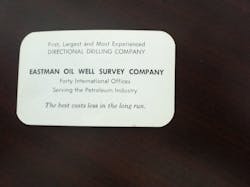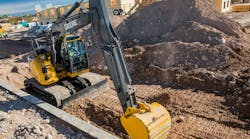This isn’t the first time I’ve crossed one of my father’s 50-year-old paths. About 10 years ago, on a business trip to South Korea, I shot a photograph of the East Gate in Seoul. Surrounded by multiple lanes of inner-city traffic and multi-story shopping complexes, the 500-year-old structure seemed out of place. Back home, I mentioned it to Dad. He took me to his Korean War albums and showed me a photo he had taken, from almost the same spot, of the very same gate. The only other item in his picture, however, was an army jeep.
The card in the photograph above sent me down another path that has crossed my dad’s, this time a path through the construction industry. Before he took up the career that I associate with him, public education, my father was in corporate communications with The Eastman Oil Well Survey Company. Finding that card sent me to the web.
I discovered that my dad worked for the man many call the father of directional drilling.
H. John Eastman is a name I’ve grown up with, and I have an image of him holding the reins of a silver-haired stallion bearing a silver-studded parade saddle. My dad took that photo, and he told me the saddle sat on a special frame on the third floor of the building housing Eastman’s Denver offices. It was recently sold at auction.
What I had missed in the conversations about H. John, as my dad called him, was that he had invented directional drilling, having been awarded a patent in 1930. This presentation, on slide 5, credits him with the technique.
What launched H. John’s reputation, however, was the application of this technique in Conroe, Texas. In January 1933, an oil strike there immediately caught fire. The well exploded, creating a 600-foot deep crater, and the oil burned for months. Although the fire was eventually put out, oil continued to flow into the “lake.” The only way to manage this was to drill another well to relieve the pressure.
H. John was brought in to drill that relief well, and in November 1933 he did it, using his technique of directional drilling. Read the account here.
His company grew into a global organization using directional drilling to reach oil under small off-shore islands and other places. The legacy of H. John now resides within the organization of Baker Hughes.
For more on the legacy of H. John Eastman, here are some resources:
- Audio recording of a 1985 interview. He describes directional drilling and the Conroe fire at 12:00. At 26:00, he talks about the then-current state of directional drilling, which accounted for half of the oil wells drilled in 1985.
- A history of oil drilling, including Eastman’s contribution.






